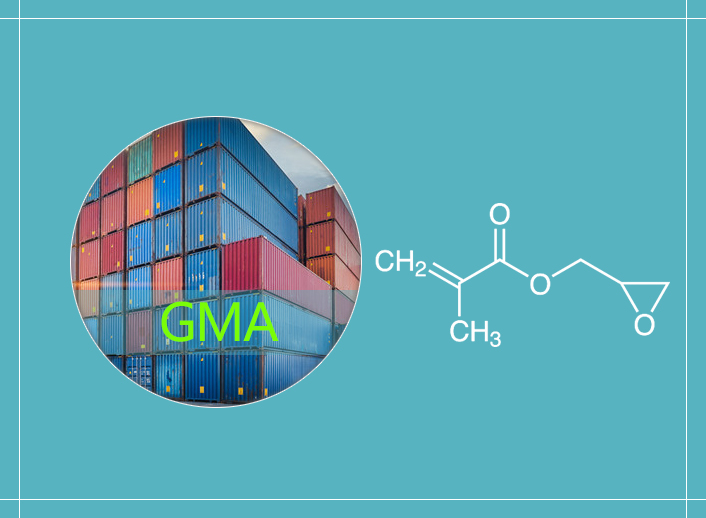The Main Industrial Application Of Glycidyl Methacrylate
Glycidyl Methacrylate (GMA) is a monomer having both acrylate double bonds and epoxy groups. Acrylate double bond has high reactivity, can undergo self-polymerization reaction, and can also be copolymerized with many other monomers; epoxy group can react with hydroxyl, amino, carboxyl or acid anhydride, introducing more functional groups, thereby bringing more functionality to the product. Therefore, GMA has an extremely wide range of applications in organic synthesis, polymer synthesis, polymer modification, composite materials, ultraviolet curing materials, coatings, adhesives, leather, chemical fiber papermaking, printing and dyeing, and many other fields.

Application of GMA in powder coating
Acrylic powder coatings are a large category of powder coatings, which can be divided into hydroxyl acrylic resins, carboxyl acrylic resins, glycidyl acrylic resins, and amido acrylic resins according to the different curing agents used. Among them, glycidyl acrylic resin is the most used powder coating resin. It can be formed into films with curing agents such as polyhydric hydroxy acids, polyamines, polyols, polyhydroxy resins, and hydroxy polyester resins.
Methyl methacrylate, glycidyl methacrylate, butyl acrylate, styrene are usually used for free radical polymerization to synthesize GMA type acrylic resin, and dodecyl dibasic acid is used as the curing agent. The acrylic powder coating prepared has Good performance. The synthesis process can use benzoyl peroxide (BPO) and azobisisobutyronitrile (AIBN) or their mixtures as initiators. The amount of GMA has a great influence on the performance of the coating film. If the amount is too small, the crosslinking degree of the resin is low, the curing crosslinking points are few, the crosslinking density of the coating film is not enough, and the impact resistance of the coating film is poor.
Application of GMA in polymer modification
GMA can be grafted onto the polymer due to the presence of an acrylate double bond with higher activity, and the epoxy group contained in GMA can react with a variety of other functional groups to form a functionalized polymer. GMA can be grafted to modified polyolefin by methods such as solution grafting, melt grafting, solid phase grafting, radiation grafting, etc., and it can also form functionalized copolymers with ethylene, acrylate, etc. These functionalized polymers can be used as toughening agents to toughen engineering plastics or as compatibilizers to improve the compatibility of blend systems.
The initiator frequently used for graft modification of polyolefin by GMA is dicumyl peroxide (DCP). Some people also use benzoyl peroxide (BPO), acrylamide (AM), 2,5-di-tert-butyl peroxide. Initiators such as oxy-2,5-dimethyl-3-hexyne (LPO) or 1,3-di-tert-butyl cumene peroxide. Among them, AM has a significant effect on reducing the degradation of polypropylene when used as an initiator. The grafting of GMA on polyolefin will lead to the change of polyolefin structure, which will cause the change of polyolefin's surface properties, rheological properties, thermal properties and mechanical properties. GMA graft-modified polyolefin increases the polarity of the molecular chain and at the same time increases the surface polarity. Therefore, the surface contact angle decreases as the grafting rate increases. Due to the changes in the polymer structure after GMA modification, it will also affect its crystalline and mechanical properties.
Application of GMA in the synthesis of UV curable resin
GMA can be used in the synthesis of UV curable resins through a variety of synthetic routes. One method is to first obtain a prepolymer containing carboxyl or amino groups on the side chain through radical polymerization or condensation polymerization, and then use GMA to react with these functional groups to introduce photosensitive groups to obtain a photocurable resin. In the first copolymerization, different comonomers can be used to obtain polymers with different final properties. Feng Zongcai et al. used 1,2,4-trimellitic anhydride and ethylene glycol to react to synthesize hyperbranched polymers, and then introduced photosensitive groups through GMA to finally obtain a photocurable resin with better alkali solubility. Lu Tingfeng and others used poly-1,4-butanediol adipate, toluene diisocyanate, dimethylolpropionic acid and hydroxyethyl acrylate to first synthesize a prepolymer with photosensitive active double bonds, and then introduce it through GMA More light-curable double bonds are neutralized by triethylamine to obtain waterborne polyurethane acrylate emulsion.